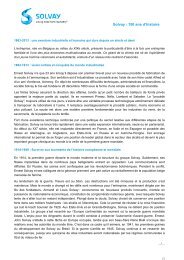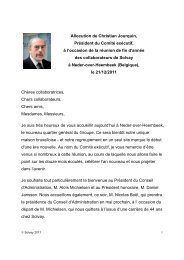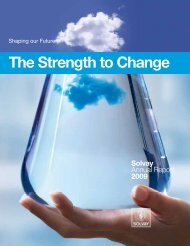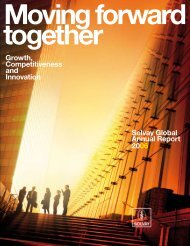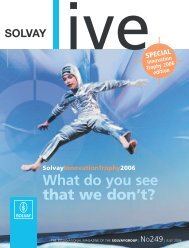Financial Statements - Solvay
Financial Statements - Solvay
Financial Statements - Solvay
Create successful ePaper yourself
Turn your PDF publications into a flip-book with our unique Google optimized e-Paper software.
54<br />
1. On a like-for-like basis, with<br />
2006 as base year.<br />
2. Number of accidents with more<br />
than 24 hours of lost time, by<br />
million hours worked.<br />
<strong>Solvay</strong> Global Annual Report 2008<br />
Quantifi ed Objectives<br />
After formalizing its Sustainable<br />
Development approach in 2007, the<br />
Group took two major steps in 2008:<br />
The June 2008 strategic review,<br />
which was entirely devoted to this<br />
theme; and<br />
Publication of the report<br />
“Towards Sustainable Development,<br />
2008-2012”.<br />
The June 2008 strategic review,<br />
the key decisions from which are set<br />
out in the “Strategy” chapter, has also<br />
translated into concrete action plans,<br />
complete with progress indicators<br />
and short, medium and long-term<br />
objectives.<br />
The 2020 objectives are structured<br />
around two action lines.<br />
The fi rst is the Group’s<br />
commitment to reduce<br />
signifi cantly its energy<br />
consumption and emissions.<br />
By 2020, the Group undertakes to<br />
reduce 1 :<br />
Its total energy consumption by at<br />
least 20%:<br />
> in its primary production and<br />
processes;<br />
> in its sites and buildings (based<br />
on energy audits);<br />
Its logistics impact (transport, in<br />
road tonne/km in Europe) by at<br />
least 20%;<br />
Its global emissions of greenhouse<br />
gases (in CO 2 equivalent) by at least<br />
20%:<br />
> including cuts in company vehicle<br />
fl eet emissions of at least 30%;<br />
Its global air emissions index by at<br />
least 20%;<br />
Its global water emissions index by<br />
at least 20%.<br />
The Group has also set itself the<br />
ambitious objective of achieving a<br />
zero frequency level for lost-time<br />
accidents 2 .<br />
In the shorter term (2012), the Group<br />
has committed to:<br />
Create an energy subsidiary<br />
to centralize management and<br />
negotiation of energy and CO 2 ;<br />
Assess the feasibility of building a<br />
chemical biomass complex;<br />
Strengthen its strategy to secure its<br />
raw materials needs;<br />
Launch a comprehensive energysavings<br />
and greenhouse gasreduction<br />
program;<br />
Use a CO 2 reference price (see box)<br />
for sensitivity analyses and decisionmaking,<br />
in all investment projects;<br />
Develop a systematic assessment<br />
of all sites based on a Best<br />
Available Technologies (BAT) model;<br />
Use Process/Markets sustainability<br />
analysis to position its products and<br />
direct its R&D programs in all its<br />
activities;<br />
Constantly review its product<br />
portfolio so as to balance<br />
opportunities and risks;<br />
Adapt the governance and improve<br />
the organization of its Research<br />
activities; and<br />
Promote the attitudes, skills<br />
and know-how needed for<br />
open innovation and a learning<br />
organization.<br />
The second action line consists<br />
of growing our product portfolio<br />
towards better a better balance<br />
of Process/Market sustainability.<br />
To this end, we are currently<br />
developing a consistent Group-wide<br />
analysis grid.<br />
The summary and prospects<br />
document “Towards Sustainable<br />
Development, 2008-2012” takes up<br />
and elaborates all these objectives.<br />
It defi nes 107 objectives at Group<br />
level, including 25 main objectives<br />
highlighted for their particular<br />
importance for the 2012 and 2020<br />
horizons. These are updated annually.<br />
This document is structured on a<br />
5X5 matrix, which constitutes the<br />
reference framework for the Group’s<br />
sustainable development thrust.<br />
It refl ects the main sustainability<br />
expectations expressed by our<br />
stakeholders vis-à-vis enterprises<br />
like ours.<br />
One axis consists of fi ve strategic<br />
elements (Vision and Values,<br />
Management Methods, Products &<br />
Activities Today, Future Development,<br />
Critical Risks), the other being<br />
<strong>Solvay</strong>’s fi ve stakeholder groups:<br />
Investors;<br />
Society;<br />
Customers and suppliers;<br />
Personnel and subcontractors;<br />
Local communities.<br />
2008 saw the Group move forward<br />
on a broad front of initiatives that,<br />
to various degrees, meet the<br />
expectations of our stakeholders.<br />
Some of the most signifi cant of<br />
these are briefl y mentioned here by<br />
stakeholder group.<br />
Defi nition of a reference value for CO 2 prices is already an integral part of<br />
our fi ve-year planning process. The values used for the fi nal year of the<br />
plan correspond to “trend” values to be used for the subsequent years of<br />
the plan and for calculating project profi tability.<br />
The defi nition of ranges of possible variations, for CO 2 , for energy and<br />
for other parameters to be used in sensitivity calculations of the return on<br />
projects, is nearing completion. This new tool will supplement the<br />
methodology for calculating the return on projects.


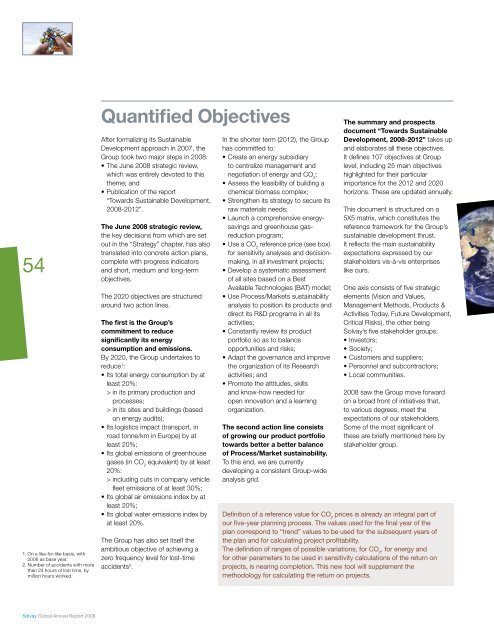
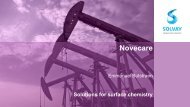
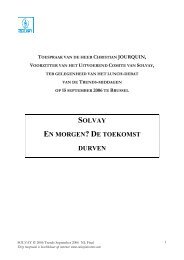
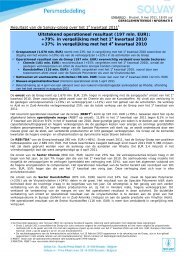

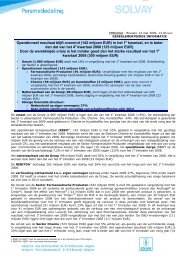
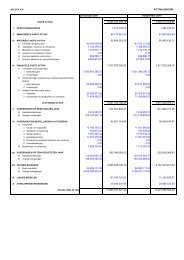

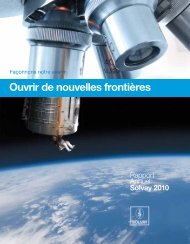
![PROC.1 [LETTRE] - Solvay](https://img.yumpu.com/16585746/1/184x260/proc1-lettre-solvay.jpg?quality=85)
